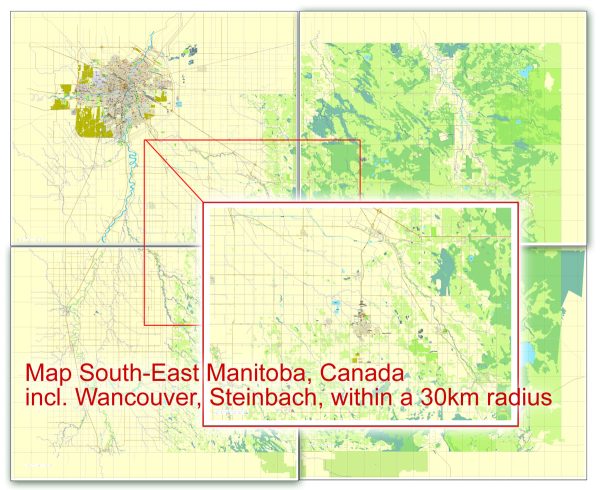Winnipeg and Steinbach are two cities in the Canadian province of Manitoba with distinct histories of urban development.
Winnipeg:
- Indigenous Presence: Before European settlement, the area now known as Winnipeg was inhabited by Indigenous peoples, including the Anishinaabe, Cree, Oji-Cree, Dakota, and Dene.
- Fur Trade Era: The fur trade played a significant role in the early development of the region. Fort Gibraltar, a North West Company trading post, was established in 1809. The Hudson’s Bay Company also had a presence.
- Red River Settlement: The 19th century saw the establishment of the Red River Settlement, a key hub for the fur trade. The settlement’s development was influenced by the Métis people, who played a crucial role in the fur trade and had a unique cultural and social identity.
- Railway Expansion: The arrival of the railway in the late 19th century further accelerated Winnipeg’s growth. The Canadian Pacific Railway and Canadian National Railway made Winnipeg a major transportation and trade center.
- Immigration and Diversification: Winnipeg experienced waves of immigration, contributing to its cultural diversity. The early 20th century saw an influx of Eastern European immigrants, and the city continued to grow as an economic and cultural hub.
- Economic Challenges: Winnipeg faced economic challenges during the Great Depression and post-World War II, but it rebounded in the latter half of the 20th century with a more diversified economy.
- Modern Development: Today, Winnipeg is a thriving city with a diverse economy, cultural institutions, and a rich history that is celebrated in various museums and historic sites.
Steinbach:
- Mennonite Settlement: Steinbach has strong ties to Mennonite history. The first Mennonite settlers arrived in the area in the late 1870s, establishing farms and communities.
- Agriculture and Trade: Like many prairie towns, Steinbach’s early development was closely tied to agriculture. The town became a center for trade and services for the surrounding farming communities.
- Cultural Influence: The Mennonite culture has had a lasting impact on Steinbach. The community has preserved its cultural heritage through events, museums, and landmarks.
- Expansion and Urbanization: As agriculture and trade expanded, Steinbach underwent urbanization. The town’s infrastructure developed to support the growing population.
- Economic Growth: Steinbach’s economy diversified over time. While agriculture remains important, the town has also attracted businesses in manufacturing, retail, and services.
- Community Spirit: Steinbach is known for its strong community spirit. Various events and festivals celebrate the town’s cultural heritage, fostering a sense of belonging among residents.
Both Winnipeg and Steinbach showcase the dynamic history of urban development in Manitoba, reflecting the influence of Indigenous communities, European settlement, economic changes, and cultural diversity.


 Author: Kirill Shrayber, Ph.D.
Author: Kirill Shrayber, Ph.D.